Photos: London's new Britannia Airport on man-made Thames Estuary island
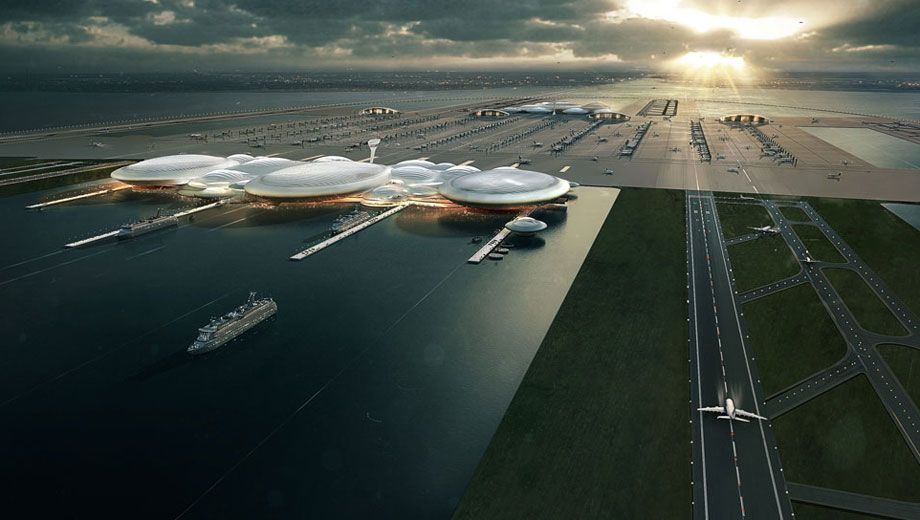
London could have a new airport built on a man-made island in the Thames estuary east of London by 2020, with high-speed rail lines to London and Europe.
London Britannia Airport, would see London's Heathrow Airport closed and converted into a community of 300,000 new houses, according to a government-backed consortium behind the proposal for the A$81 billion (£47.3bn) project.
The runway configuration would allow three or four aircraft to operate at the same time, 24 hours a day, allegedly in all weather conditions.
Britannia Airport would be "car free, with no private car access". To streamline passenger movements, check-in and arrivals terminals would be located at London's King's Cross railway station and the Ebbsfleet International railway station on the HS1/Eurostar line, with high-speed rail links to the airport.
The airport would include a dock so that goods could be shipped to and from the new London Gateway superport rather than clogging up roads.
London Britannia Airport is the second of two proposals for an airport in the Thames estuary, but unlike a rival pitch from Foster+Partners would be constructed on an artificial island instead of converting the current outcropping Isle of Grain (as shown below).
Opting to build a bespoke island allows the location to be chosen to minimise noise and be tailored for transport links says the Thames Estuary Research and Development (Testrad) consortium formed by London Mayor Boris Johnson to study the options for estuary airports.
“In many respects, this is the most ambitious of all the airport proposals, the least contentious, the easiest and the most cost effective solution,” says Ian Mulcahey, managing director of international architectural firm Gensler, which is part of the consortium.
A new airport is needed to supplement or potentially replace the congested Heathrow Airport, which is currently running at an estimated 99% capacity.
London Britannia Airport would handle over 200 million passengers per year, making it one of the world's largest airports.
Follow Australian Business Traveller on Twitter: we're @AusBT
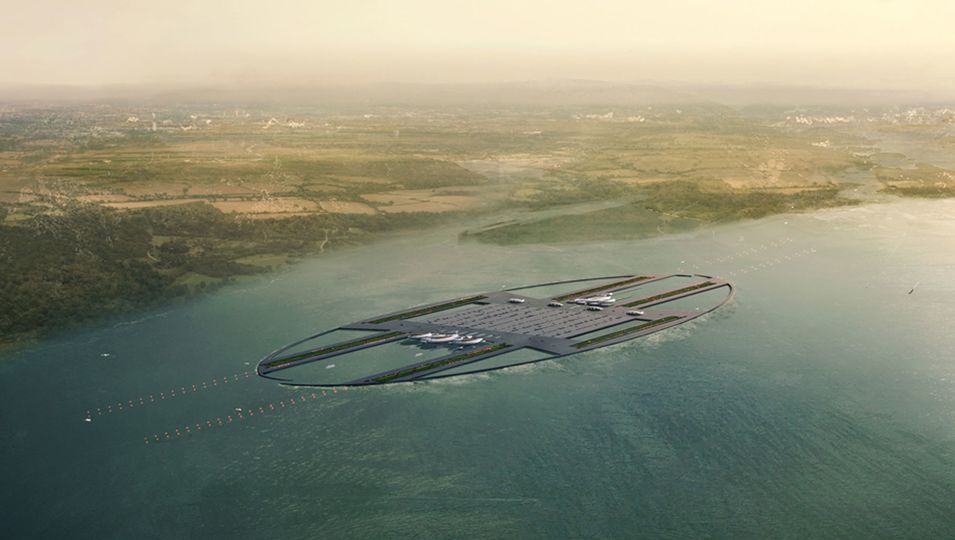
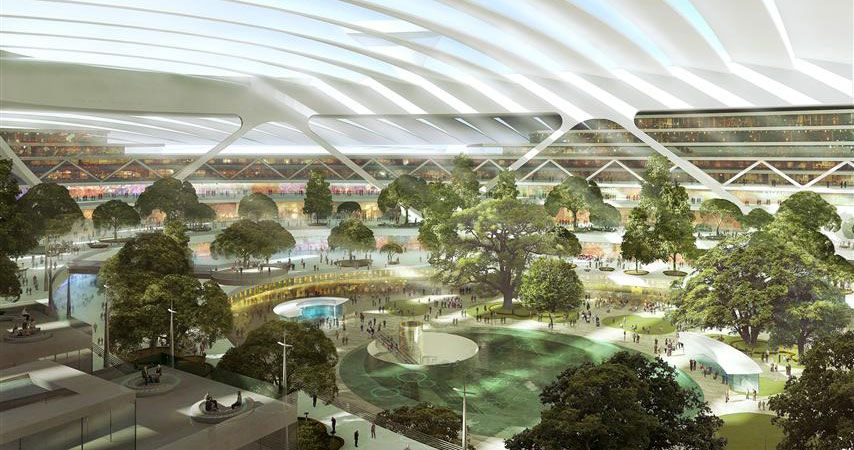
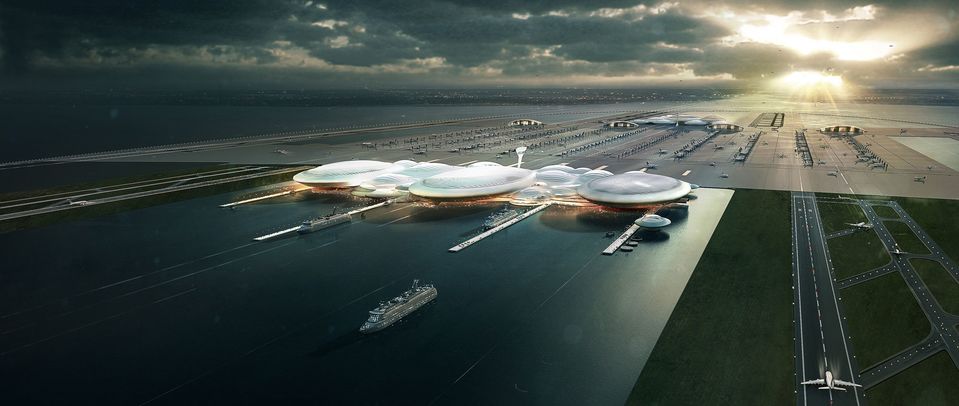

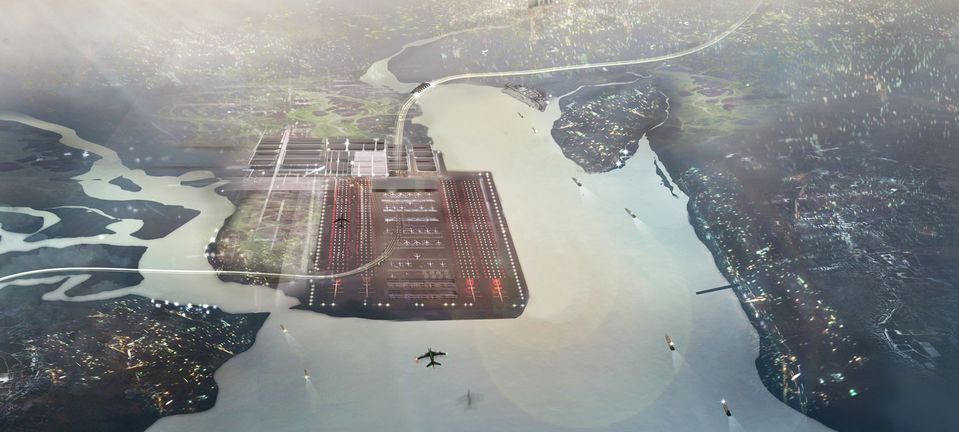

30 Aug 2013
Total posts 438
Apart from the massive cost, what's the catch? It seems like a perfect idea to have a 24 hour airport that can handle 200m passengers a year (3 times the current passenger movements)?
The no-car high-speed rail accessibility also seems like a great solution.
12 Jun 2013
Total posts 732
Well, there's the massive cost.
And the fact that London probably doesn't really *need* an airport to handle three times the current passenger movements any time in the next few decades, making this a potential disaster on an even larger scale than... what's that unused airport at Montreal?
And the fact that this is further from town than Heathrow/Gatwick/Stansted/Luton though possibly quicker to get to due to high speed rail (but then again, why not just build high speed rail to Luton?)
And finally, just wait 'til the local environmentalists get a hold of the idea that you want to build a giant airport on the oh-so-fragile Thames estuary which is, no doubt, home to some unique species of mud worm or something.
12 Nov 2013
Total posts 8
Even talking about the cost.. it says the airport will cost £47b and sale of the old land to developers will reap £45b? So even the cost in the long run, is practically nothing (well ... what's £2b compared to £47b?)
12 Jun 2013
Total posts 732
It says the airport will cost 47 billion dollars and that the sale of Heathrow will yield 45 billion dollars. It also says it can be built in six years. I'd wager all these numbers are equally fictitious.
12 Jun 2013
Total posts 732
Sorry, I meant pounds, not dollars, but you get the idea.
Qantas - Qantas Frequent Flyer
07 Jul 2013
Total posts 12
To afford the gap between the sale of Heathrow and the building of this new airport, it will probably be partly privatised and bits sold off to other companies.
21 Apr 2012
Total posts 3006
Catch = Poor project management + Political backtracking + Environmentalist nuts jobs + blue rinse brigade from your local council
Call in your Japanese and Singaporeans to deliver the project and just watch it happen.
Qantas - Qantas Frequent Flyer
20 Aug 2012
Total posts 124
Meanwhile back in Australia, it is envisaged that by the same year (2020):
It’s truly amazing to see how other developed (and developing) nations are able to create large infrastructure projects, without needing to spend years and years (in some cases decades) in just contemplation and discussions. In Australia, there always seems to be far to much talking and deliberation about infrastructure, before ACTION is finally taken. When ACTION and infrastructure work completed, it is almost time to upgrade again….
(My Tuesday morning rant…I need to get some good coffee in me, I think.)
A fridge magnet I have say's it all:
"After all is said and done...more is always said, than done".
QFF
12 Apr 2013
Total posts 1564
London alone has 1/3 of all Australia population. Plus it is big hub that serves whole Europe on way to Americas, Asia and even Australia.
Meanwhile in Australia we have virtually no external transit (just some Kiwis) and we have to support 3 (or even 4 if Perth counts) relatively big international airports.
Mate, we are small nation sitting in far corner of globe (though huge one) – there are certain benefits in this situation as well as certain disadvantages.
Cheers.
Qantas - Qantas Frequent Flyer
20 Aug 2012
Total posts 124
Hi Serg,
I do take on your point, however in this case population isn't necessarily the yard stick we should use in this case.
The best yard stick should be aircraft movements, as we are really discussing runway usage. This is because it takes approximately the same amount of time for a light turbo-prop / light jet aircraft to occupy a runway as it does for heavier aircraft such as an A380/B747. I do understand Brisbane (or Australia for that matter) is not an international hub, and that due to our geographical position, that Brisbane has a lower flow of international traffic. However ,their dominant traffic 'movements', by a significant number, are domestic (including FIFO) aircraft.
Statistically in 2012 London had 1288 movements per day for two runways i.e. 644 per main runway.
In 2012 Brisbane had 574 movements per day per main runway.
So to break it up on a movement (per runway) basis, Brisbane's runway is only 11% quiter (less occupied) than Heathrows at any given time. Heathrow Airport can't grow in terms of movements anymore (99% capcity as per the article), Brisbane AIrport continues to grow at approx. 4% per year.
Which is why they have had a need for over a decade now for a 2nd runway at Brisbane. (The street directories have had the 2nd runway penciled in for 6 years already!). Slot allocations for operaters have been introduced, and runway occupancy procedures are just about to be implemnted to help alleviate the extensive holding that most aircraft suffer when flying to Brisbane Airport.
QFF
12 Apr 2013
Total posts 1564
Population make all the difference. Actually not population as such but passenger number that ultimately depends on population (plus transit). Money came from taxes and from tickets. Amount of taxes depends on population. And as per your explanation we actually far worse – in Brisbane they have more small aircrafts with fewer passengers that occupy the same time slot as massive jumbos with hundreds of passengers and those jumbos actually even queued for takeoff.
Once again – we are small nation, yet we have to support massive infrastyructure.
Qantas - Qantas Frequent Flyer
20 Aug 2012
Total posts 124
Without the needed infrastructure Serg the economy will suffer . Those smaller FIFO planes go to small communities (mines) that help generate billions for the economy.
According to estimates the runway is expected to cost $1.3 Billion dollars.The economic benefits for the queensland region are expected to reach $5 billion per year, by 2035.
The long-term proposition is the economic gains for the community, significantly outweigh the cost of the infrastructure.
12 Jun 2013
Total posts 732
This airport is even more of a pipe dream than Badgery's Creek at this stage, so I wouldn't get too worked up about how quickly they do things over there compared to over here. There is absolutely no way the Brits are going to actually build this thing in six years.
Just for reference, the initial design studies for Heathrow Terminal 5 started in 1988. The architect was hired in 1989. The proposal was formally announced in 1992, and a formal planning application was submitted in 1993. A public inquiry into the proposal began in 1995, and ended in 1999 after sitting for 525 days. In 2001, the government granted permission for the terminal to be built. In 2002, they actually started construction work. And in 2008, the terminal opened.
And that was just one terminal. And it was built on land, not water.
Qantas - Qantas Frequent Flyer
05 Feb 2013
Total posts 54
Skipp, do you really think a new London airport will be built by 2020? Look how long it took for the approval process, and then construction, of Heathrow Terminal 5. The UK has a similar pace to Australia on major infrastructure.
Cathay Pacific - Asia Miles
25 Apr 2013
Total posts 542
Which airport will CX fly to?
24 Oct 2010
Total posts 2563
Alvin, given this airport would not even be built until 2020 (if it's built at all, as it's only a proposal) I think you don't need to worry about which airport CX would use until, well, 2020...
Cathay Pacific - Asia Miles
25 Apr 2013
Total posts 542
Does that mean 7 more years of Heathrow?
12 Jun 2013
Total posts 732
No, it means several more decades of Heathrow, because strip away the attention-grabbing BS inserted into the press release and this is nothing more than some computer renderings and some wishful thinking.
2020 is barely six years away, government decisionmaking doesn't move that fast. At best you can expect the completion an initial inquiry to recommend that another inquiry be set up into determining whether a formal design study should be undertaken.
Qantas - Qantas Frequent Flyer
20 Sep 2011
Total posts 24
Isn't the Thames Estuary subject to occasional massive tidal / storm surges? Could these innundate the airport, especially if the "warmist / alarmists" are to be beleived and the sea level is to rise by, depending on who you listen to, maybe even Al Gore's 10 meters? And an airport only served by a single high speed rail link would be enormously vulnerable to aither accidental or terrorist disasters or even threats. Certainly it is a nice idea to only have rail links but perhaps not practicable.
25 Sep 2013
Total posts 1242
Wow how futuristic looking. Does weather-proof extend to rising sea levels?
American Airlines - AAdvantage
04 Jul 2012
Total posts 15
2020? Ha.. It might be that time for the politicians to finish arguing before a 'study' takes place and whether such creatures as the (pretend) Thames Freshwater crab will survive amid all the noise planes flying in to land !
One of the reasons the way Heathrow looks so Third World is just that the British have no farsight in planning.
2020 will see Singapore Changi open T5. Heathrow will still be plodding along .. as long as it doesn't rain, snow , sleet or have too many leaves blow onto their runways.. and oh ya, ADP will be raised to £180 for a long haul economy flight now.
Hi Guest, join in the discussion on Photos: London's new Britannia Airport on man-made Thames Estuary island